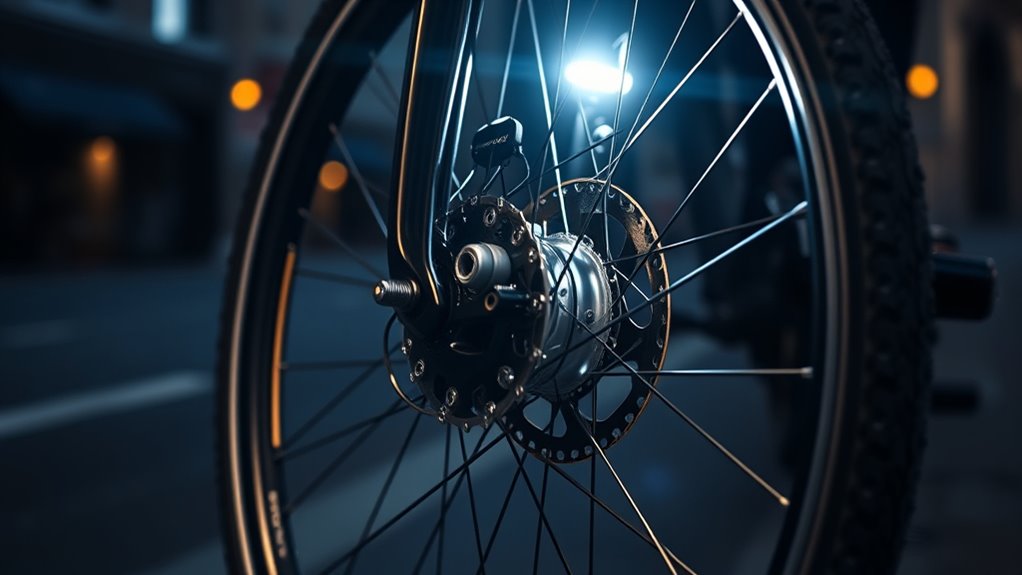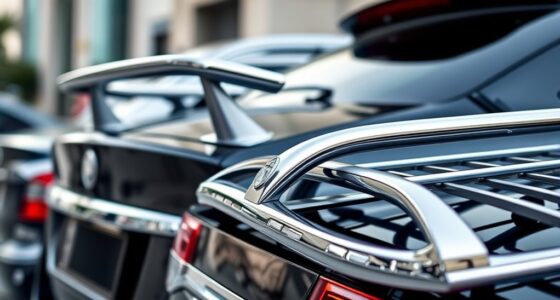Dynamo lighting systems generate electrical power through your bike’s movement, offering a reliable and eco-friendly way to light your path without batteries. As you pedal, a built-in dynamo converts mechanical energy into electricity, powering your lights instantly. These systems are durable, low-maintenance, and eliminate worries about battery life. If you want to know how these innovative solutions evolved and their benefits, keep exploring the details below.
Key Takeaways
- Dynamo lighting uses mechanical energy from bike movement to generate electricity for illumination without batteries.
- It operates via a dynamo hub integrated into the wheel, converting pedaling motion into electrical power instantly.
- Modern designs focus on durability, efficiency, and reliable performance, eliminating power depletion concerns.
- Dynamo systems provide continuous, eco-friendly lighting, reducing costs and environmental impact compared to battery-powered lights.
- They are a sustainable solution rooted in over a century of technological evolution, enhancing portable and bicycle lighting.

Have you ever wondered how some flashlights and bike lights stay illuminated without batteries? The answer lies in the fascinating world of dynamo lighting, which uses mechanical energy to generate electrical power. Unlike traditional battery-powered lights, dynamo systems rely on battery integration principles that convert your physical movement into usable electricity. This concept isn’t new; it has a rich historical development that dates back over a century. Early inventors sought ways to power lights without the hassle of replacing batteries, leading to innovations that would eventually transform bicycle lighting and portable illumination.
Dynamo lighting uses mechanical energy to power bike lights without batteries, dating back over a century of innovation.
Initially, dynamo lighting was introduced as a practical solution for cyclists who needed reliable, eco-friendly illumination without the inconvenience of batteries. The earliest systems used simple magnets and coils to produce electricity when the wheel turned. As technology advanced, so did the efficiency of these systems, incorporating better materials and design improvements that increased the amount of power generated. The historical development of dynamo lighting demonstrates a shift from bulky, inefficient setups to sleek, highly effective units that seamlessly integrate with modern bicycles. This evolution was driven not only by technological progress but also by the growing awareness of sustainability, making dynamo lighting an environmentally friendly alternative to battery-powered lights.
Today, you’ll find dynamo systems embedded into many bikes, especially those used for commuting and long-distance riding. They operate by harnessing the mechanical energy produced when the wheel spins, turning a small generator or dynamo hub integrated into the wheel itself. As you pedal, the dynamo converts this motion into electrical energy, powering your front and rear lights instantaneously. This continuous generation of power means you don’t have to worry about batteries running out or replacing them. Instead, your movement sustains the illumination, providing a reliable lighting solution that’s both eco-conscious and cost-effective.
The design of modern dynamo systems emphasizes durability and efficiency, with innovations like integrated lighting hubs and improved coil windings. These advancements mean that your bike lighting is not only more reliable but also less prone to failure over time. The historical development of these systems has paved the way for their widespread adoption, especially in regions where sustainable transportation is prioritized.
In essence, dynamo lighting exemplifies how understanding the principles of battery integration and leveraging technological advancements can lead to practical, sustainable solutions. It’s a perfect example of how innovation rooted in history continues to shape our everyday experiences. Whether you’re commuting or exploring, you can appreciate how this age-old technology keeps you illuminated on the move—without batteries, just pure mechanical energy transformed into light.
Frequently Asked Questions
How Long Does a Typical Dynamo Light Last Before Needing Replacement?
A typical dynamo light lasts around 2,000 to 10,000 hours before requiring replacement, depending on usage and quality. You should check the battery life regularly and watch for dimming or flickering, which indicate it’s time for a replacement. Replacement intervals vary, but generally, you might need to replace the bulb or internal components every 1-3 years with regular use to ensure consistent brightness.
Are Dynamo Lights Effective During Long Outdoor Excursions?
While dynamo lights might seem like a modest choice, they’re quite effective during long outdoor excursions if you pay attention to generator efficiency and cable durability. You’ll find they provide reliable illumination when properly maintained, ensuring you don’t get left in the dark. Just make sure your generator runs smoothly and your cables stay intact, so your lighting stays consistent, no matter how extended your adventure becomes.
Can Dynamo Lighting Systems Be Integrated With Solar Power?
Yes, you can integrate dynamo lighting systems with solar power, creating hybrid systems with solar compatibility. This setup allows you to harness solar energy alongside your dynamo, ensuring continuous illumination even when you’re not cycling. By combining these power sources, you benefit from reliable, eco-friendly lighting that adapts to your needs during long outdoor excursions, enhancing safety and convenience without relying solely on one energy option.
What Maintenance Is Required for Optimal Dynamo Performance?
To keep your dynamo lighting system performing at its best, regularly check the cables for wear or damage and ensure they’re securely connected. Additionally, perform battery maintenance by inspecting and charging the battery as needed to prevent it from losing capacity. Clean the dynamo and the contact points periodically, and avoid prolonged disuse. These simple steps will help you maintain reliable lighting whenever you need it, on or off the move.
How Do Dynamo Lights Compare in Brightness to Battery-Powered Alternatives?
Dynamo lights typically provide comparable brightness to battery-powered options, thanks to advanced LED technology. While battery efficiency varies with usage, dynamo lights offer a consistent, eco-friendly brightness without worrying about batteries running out. You’ll notice that LED technology enhances brightness, making it easier to see on dark trails. Overall, dynamo lights are a reliable, sustainable alternative that delivers impressive illumination without the need for frequent battery replacements.
Conclusion
Now that you know how a dynamo keeps your lights shining on the go, you’re ready to hit the road with confidence. Think of it as a reliable engine, silently working behind the scenes to power your adventures. With this smart technology, your journey stays illuminated no matter where you’re headed. So, embrace the power of movement—your dynamo is your trusty lighthouse guiding you safely through the dark.









